Savoring Bordeaux: A Blend of Cycling and Wine Tasting
Where French Wines Get Better With Age
By Michael Kerwin
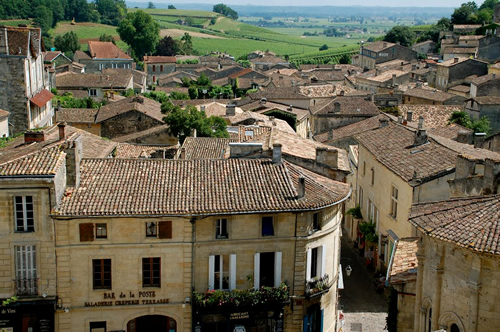
|
|
One of many beautiful villages in the wine-growing region of Bordeaux.
Photo by Lies Ouwerkerk.
|
Bordeaux. The good news for the cycling oenophile is that bicycle rental and tasting opportunities are easy and inexpensive. The bad news is that Bordeaux is the largest fine wine district on earth, slightly smaller than Connecticut, and includes approximately 5,500 producers. In fact, the Conseil Interprofessionel du Vin de Bordeaux divides it into six regions: Médoc, Graves/Pessac-Léognan, the sweet white wine region, Bourg/Blaye, St-Emilion-Pomerol-Fronsac, and Entre-Deux-Mers.
The Médoc is located on the southeast side or left bank of the Gironde estuary, formed by the confluence of the Dordogne and Garonne Rivers, and is Europe’s largest estuary. To its south, on the other side of Bordeaux city, the Graves/Pessac-Léognan region stretches for 30 miles along the southwest side of the Garonne River; most of the sweet white wine region is embedded in its southern half. Bourg/Blaye lies on the northeast side or right bank of the Gironde estuary and continues for several miles along the north side of the Dordogne River. St-Emilion-Pomerol-Fronsac is located to its east, also on the north side of the Dordogne. Entre-Deux-Mers lies between the Dordogne and Garonne Rivers.
The geology, soils, and type of grapes produced differ in each region. St-Emilion, for example, rests upon a limestone plateau; its soil contains a significant amount of clay, and 60 percent of its grapes are Merlot. The Médoc was once marshland; its soils are a mixture of gravel and sand, and most of its grapes are cabernet sauvignon.
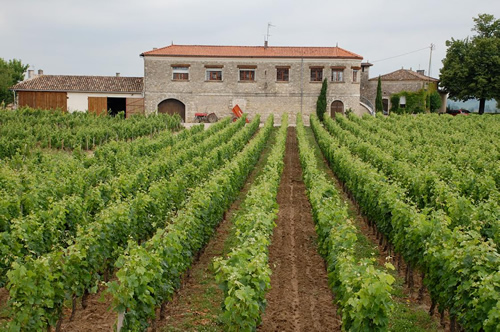
|
|
A vineyard in Bordeaux. Photo by Lies Ouwerkerk.
|
The most efficient way for wine lovers to learn about Bordeaux wines is to start at the Maison du Vin in Bordeaux, one of the world’s premier schools for sommeliers, and sample wines from several regions. (The Maison du Vin is conveniently located next to the Quinconces tram station, and the shuttle bus from the airport stops there.) For about $10, the oenophile can taste red wines from the Médoc, Graves/Pessac-Léognan, and St-Emilion regions, and the barman, an expert sommelier, can answer questions.
With this preparation, cyclists have two options: They can spend a couple of days in Bordeaux city or go into the countryside and start pedaling. Staying in the city for two or three days allows them to take advantage of one of the bus tours offered by the Bordeaux tourist office. Each day of the week, Sunday through Saturday, the tourist office takes visitors to chateaus in different wine regions. The Saturday tour, for example, goes to two chateaus in the Médoc. Because the city and the Gironde estuary separate the Médoc from the other regions, going there by bus simplifies the route for touring the different regions. It also introduces the oenophile to the vintification process and how it differs from chateau to chateau.
When I toured the Médoc, I visited Chateau Pédesclaux in Pauillac and Chateau Baudan in Listrac. Bilingual guides at each chateau (French and English) explained the vintification process. At Chateau Pédesclaux, a staff of trained workers performs each operation step. At Chateau Baudan, on the other hand, a husband and wife do almost everything. At Chateau Pédesclaux, the wine is stored in new French oak barrels in a brightly lighted warehouse-like structure. At Chateau Baudan, the barrels are older, and the dark storage building, called a chais, has a dirt floor, thick limestone walls, and a single north-facing door.
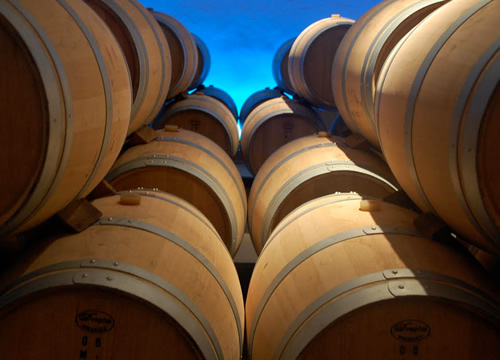
|
|
Wine stored in oak barrels. Photo by Lies Ouwerkerk.
|
Knowing how wine is made gives cyclists an advantage when they visit other chateaus along their route because they can ask intelligent questions. When winemakers realize that a visitor knows about vinification, they often provide tasting opportunities that other visitors might not have. When a visitor asks if any sugar was added during fermentation, the winemaker may say, “Yes, we added a little sugar in 2004, but let me have you try 2005 when we added no sugar.”
Exploring the Bordeaux Wine Region on Two Wheels
St-Emilion
The village of St-Emilion is a short train or bus ride from Bordeaux. It provides an excellent location for the cycling oenophile to explore St-Emilion-Pomerol-Fronsac, Graves/Pessac-Léognan, Entre-Deux-Mers, and the sweet white wine region. The tourist office of St-Emilion and Gites de France provide a list of accommodations. The tourist office also rents sturdy bicycles from $20 a day.
St-Emilion, like Bordeaux, has a Maison du Vin. Visitors can test their sense of smell at its aroma table, an essential skill in identifying and assessing wine. Three three-inch diameter pipes protrude from the top of each side of the table. On the table’s surface, below each pipe, is a set of three buttons and a red light. One set of buttons, for example, is “rose,” “violet,” and another flower. Another is “vanilla,” “cinnamon,” and “clove.” The visitor slides the cover from the mouth of the pipe, inhales the fragrance, and pushes the button that names it. The red light signals if the correct choice has been made. The Maison du Vin’s wine shop also sells wine at the same prices that the chateaus sell it.
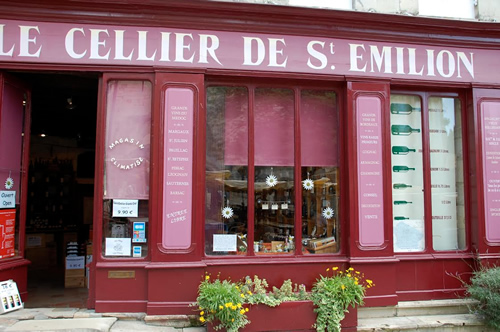
|
|
A wine shop in Bordeaux. Photo by Lies Ouwerkerk.
|
St-Emilion also has several restaurants that prepare food to showcase its wine. Among them are L’Envers du Décor, near the tourist office, and Tertre. Bordeaux, one should be warned, is not a place for vegetarians. Foie gras is a traditional meal, followed by veal simmered with carrots, onions, and potatoes.
Must-Visit Vineyards and Cycling Routes in Bordeaux
In Bordeaux, France: Plus Saint-Émilion, Arcachon, and Bordeaux Wines, B G Preston outlines cycling tours of the Gironde area, including St-Emilion, Arachon on the coast, and Médoc regions. A shorter option is to cycle through the satellite regions of St-Emilion — Montagne, Lussac, and Puisseguin — and return to St-Emilion. Both routes enable cyclists to visit Saint Martin de Montagne and eat lunch at Restaurant Le Vieux Presbytere. The shorter circuit also allows the cyclist to see two other Romanesque churches along the pilgrimage road from Vezélay in Burgundy to Santiago de Compostella in Spain. To follow either route, find the maps published by the Institut Geographique National.
Venturing further afield, Cadillac, 40 kilometers south of St-Emilion, is an easy morning ride. Hotel Restaurant Detrée offers a menu du jour for about $10 and a chance to sample the white wine of Entre-Deux-Mers. By arriving on Saturday, when the market is held, cyclists can buy baguette and cheese and picnic on the bank of the Garonne River.
By planning to spend the night in nearby St-Macaire, the cyclist goes from Cadillac through Loupiac, known for its sweet white wine. When I visited Loupiac, I stopped at Chateau du Cros and was greeted by two massive, menacing dogs. Fortunately, Madame Boyer was getting out of her car and told the dogs to stop. She asked me if I’d be willing to wait until her son arrived and invited me into her kitchen for coffee!
Visiting Chateau du Cros, I learned about the wines of Graves/Pessac-Léognan, the sweet white wine region, and French history. Madame Boyer pointed out the fortress hidden in the trees on the ridge above her chateau. I could see a tower rising above the trees. That fortress, symbolized on the chateau’s wine label, is associated with Eleanor of Aquitaine and Richard the Lion-Hearted.
Finding Affordable Quality: Bordeaux Wine Prices
Lodging at St-Macaire allows the cyclist to fully explore the Graves/Pessac-Léognan and sweet white wine regions. The tourist office provides a list of accommodations. Another option is to continue east to Duras, a fortified hill town in the Lot and Garonne Department. Although Côtes du Duras is not classified as a Bordeaux wine, it is an excellent value at $10-$15 a bottle. However, bargain hunters will be disappointed when searching for inexpensive Bordeaux wines. Some wines, such as those from the satellite regions of St-Emilion, can be purchased for $20 to $40 a bottle, but most chateau-bottled wines range from $25 to $50 and on up.
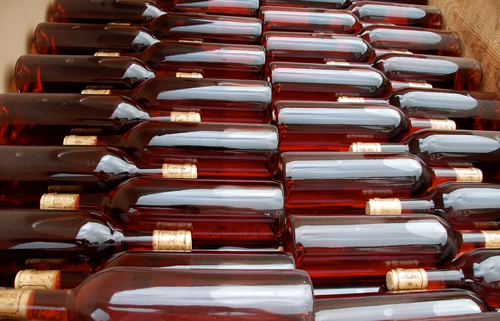
|
|
Bottles of wine stored in a cave in Bordeaux. Photo by Lies Ouwerkerk.
|
The best wine values are in the Bourg/Blaye region, 60 kilometers east of St-Emilion, where a 50 cl. Carafe can be purchased for less than $6-$8. The easiest way to reach Blaye is by bus, which takes the traveler to the Blaye tourist office. The staff there can direct visitors to accommodations and the shop renting bicycles. The cyclist can stay on a route which hugs the estuary shore, available as a map from the Institut Geographique National.
After visiting Bordeaux, wine lovers will appreciate the great care with which Bordeaux wines are made and their diversity. They will also know the foods that pair (the French say “marry”) with them. Few places on earth allow the cycling oenophile to learn about legendary wines while cycling through a countryside that has changed little since medieval pilgrims traversed it on their route from Vezélay, Burgundy in France to Santiago de Compostella, Spain.
Michael Kerwin is a professional tour guide, teacher, writer, and oenophile. His stories have appeared in Bicycle USA, Bluegrass Tomorrow, Keeneland Magazine, and The Chevy Chaser Magazine.
|
